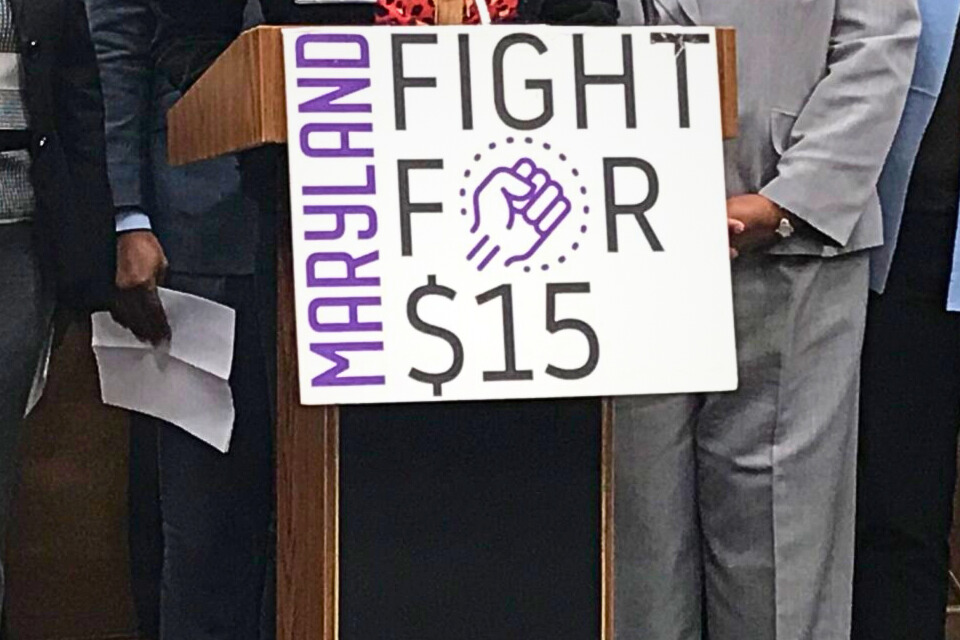Minimum wage increase on the horizon for most, some will get there sooner

Starting Saturday, most business owners around the state will have six months to prepare for a coming jump in the state’s minimum wage.
The Fair Wage Act of 2023, passed earlier this year, was a priority for Gov. Wes Moore (D) in his first year in office. The change accelerates the move to $15 per hour as phased in under a 2019 law.
Aaron Seyedian, owner of Well-Paid Maids, said business owners should embrace the coming change because of its overall benefits.
“The cost of living is high here and so this kind of Wal-Mart model where the state, according to some people, can kind of withstand a kind of race-to-the-bottom economics, that’s just not the kind of economy Maryland has. It’s in line with our history and our reality … to say you know, things tend to cost a bit more so people need to be paid a bit more. I think it’s pretty rational when you think about it that way.”
In Maryland, a single adult must earn $19.61 per hour to cover basic living expenses, according to the Massachusetts Institute of Technology’s living wage calculator. Regionally, in western Maryland and the Eastern Shore, that living wage is about $4 less.
The coming increases “amount to pennies on the dollar” to business owners, Seyedian said.
“I just don’t think that it’s the thing that business success hinges on,” he said.
Seyedian, who started his business in 2017, has nearly three-dozen employees in the Maryland-DC-Virginia area. About half live in Maryland and a third service clients in the state.
Employees of the company won’t be directly affected by the coming change or the increase in Montgomery County that takes effect Saturday.
In that county, companies with 51 or more employees will pay $16.70 per hour. Small companies of 11-50 employees will have a minimum wage of $15.00. Smaller employers in that county will pay $14.50 per hour.
Seyedian’s employees already earn $23 per hour. He said paying his employees more has lowered job turnover. He said it also allows his employees to improve their standard of living, pay for childcare and even take a nicer vacation.
Alissa Barron-Menza, vice president of Business for a Fair Minimum Wage, said accelerating the increase in Maryland helps keep up with the cost of living and with low-cost of living states such as Nebraska, which will hit $15 per hour in 2026.
“It didn’t make a lot of sense that Maryland was going to get to $15 at a slower than a place like Nebraska where cost of living is just considerably less,” said Barron-Menza.
And while Maryland is in the “middle of the pack” of states moving to $15, Barron-Menza says others are beginning to look at minimum wages between $18 and $20.
Four years ago, the General Assembly passed a phased-in increase of the minimum wage over the objections and veto of then Gov. Larry Hogan (R). Large businesses would have been required to reach $15 per hour by January 2025, followed by smaller businesses in July 2026.
With the new legislation, the accelerated time frame means all employers in Maryland, regardless of the number of employees, will be required to pay at least $15 per hour in January.
Currently, the minimum wage for businesses with 15 or more employees is $13.25 per hour. The rate is $12.80 per hour for smaller businesses.
“It means thousands of dollars in increased labor costs,” said Mike O’Halloran, the head of NFIB-Maryland. “It’s not just those starting at the new minimum wage. One of the things we told legislators about is the idea of wage compression. Those folks who have been with a company two or three years who are earning $17 or $18 or $19 an hour, they’re going to want to see their wages go up as well. Who can blame them?”
Moore made accelerating the increase a priority in his first legislative session as part of an effort to grow the economy and address poverty. The new law takes effect July 1 with the increase landing in January.
Lawmakers agreed but balked at Moore’s desire to link future increases to inflation as was done in Montgomery County.
“It really is a best practice,” Barron-Menza said of automatic cost of living increases.
The legislature also removed a provision passed in 2019 that allowed the Board of Public Works to temporarily pause increases in dire economic conditions.
Paul Frey, president and CEO of the Washington County Chamber of Commerce, said the mandated increased wages are pushing more businesses in his region to move to automation and self-checkout. That means fewer jobs for low-skill or first-time workers.
Additionally, Frey said the increase won’t be meaningful to employees in the end.
“What ends up happening is the people you’re trying to help, the low- and middle-income families, their costs of living goes up, too, and their disposable income doesn’t change,” said Frey.
“The only winner ends up being the state government because they get increased revenue because taxes go up,” he said.
Barron-Menza rejected claims that an increase in wages drives up costs.
A 2019 paper published by the Federal Reserve Bank of Boston found that a 10% increase in wages resulted in a 0.3% increase in prices.
“That’s a nominal increase and it’s eclipsed by a larger group that can now go out to eat,” said Barron-Menza, adding that more recent inflationary pressures are tied to global conflicts, the pandemic and supply chain issues.
The coming increase exposed the state’s sometimes difficult relationship with small business owners. Many felt the legislature reneged on a 2019 deal to ease into $15 per hour rate.
“First, it’s broken promises to the private sector,” said Frey. “This was not supposed to take place until 2025 for larger employers and 2026 for those with less than 15 employees.”
Frey said many employees in Western Maryland are already being paid $15 or more.
“The concern is that they should let the market determine what the wages are,” said Frey. “On top of inflation of 6% to 9%, the cost of groceries, cost of layering all the recent policies like sick and safe leave and family medical leave insurance that’s coming, all those on top of minimum wage is just a lot more than many small businesses can absorb so they pass the costs on to the customers.”




 Creative Commons Attribution
Creative Commons Attribution